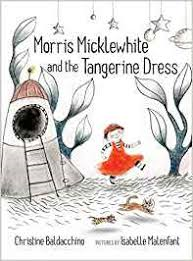MORRIS
MICKLEWHITE AND THE TANGERINE DRESS
Written
and Illustrated by Christine Baldacchino
(Groundwood
Books, 2014)
10,000
DRESSES
Written
by Marcus Ewert
Illustrated
by Rex Ray
(Seven
Stories Press, 2008)
There
are books that make me wish I weren’t taking a leave of absence as
an elementary school principal. There are funny ones I long to read
to a group of eager kindergarteners or a room of resistant grade
sevens. There are captivating picture books with a-ha moments that
require an immediate second read to marvel over how the author
surprised the audience. And then there are the teachable books, the
ones with insights that build awareness and transform the reader with
new understandings. Morris Micklewhite and the Tangerine Dress and
10,000 Dresses are two
books I’d like to workshop, with staff, with students, with
parents. Fictional characters like Morris and Bailey can make the
lives of many real people a little easier.
First
up, Morris. He lives with mother Moira and his cat Moo. (Yes, the
alliteration is a little heavy at the get-go.) Morris is one of
those youngsters who likes many things. “Mondays are great,” we
are told, “because on Mondays, Morris goes to school.” So many of
the things he likes happen there. What Morris likes most is center
time, when he chooses to play dress-up. That’s when he gets to wear
the tangerine dress which “reminds him of tigers, the sun and his
mother’s hair.” He loves the swishes and crinkles he hears while
moving in the dress and the click, click, clicks from the shoes he
wears with it. But, “[s]ometimes the boys make fun of Morris.
Sometimes the girls do, too.” Soon Morris doesn’t want to go to
school.
On
the title page of 10,000 Dresses, we
see Bailey, smiling and wearing a simple white t-shirt and underwear.
The message: this is a boy.
But the story opens, perhaps
jarringly with, “Every night Bailey dreamed about dresses.”
There’s some awkward language about a stairway in a “red
Valentine castle” that had me frowning, but this is more of a
message book than a literary marvel. Bailey’s dreams involve
dresses of rainbow-flashing crystals and lilies, roses and
honeysuckles. Her dreams are instantly dashed by her parents. (Yes,
this 2008 book uses preferred pronouns of she and her for Bailey.)
“You’re a boy,” his mom says. “Boys don’t wear dresses!”
And
Bailey’s response is heartbreaking: “But...I don’t feel like a
boy.”
There
have always been Morrises and Baileys. But, in my day, they would
have to change. They would have to don and dream of dresses in
secret. Either that or the bullying would be relentless, stretching
from kindergarten to the great beyond. Morris would be mocked as
“Margaret.” “Melissa.” Or the much-maligned, all-purpose
sissy taunt: “Nancy.” But we’re in a time now when most would
recognize that it’s everyone else that needs to adjust. Morris is
just being Morris. Bailey can be whoever she wants. Why should anyone
have a problem with that?
Sadly,
they still do. As early as kindergarten, boys know to avoid pinks and
purples and to leave the dolls alone in the play centers...unless
they are being used to fire out of a make-believe cannon. Gender
roles are established, whether it’s due to nature, nurture or a
combination.
A
colleague of mine shared how she refused to buy toy guns or other
weaponry for her two boys and yet, even before they learned to wave,
they were using their thumb and index finger to form a quick-draw
gun. Bang! Bang! As I shopped for my cousin’s baby shower this
summer, I was dismayed that so much, from cards to gift bags to
stuffed animals, came in pink or blue. Baby Jack’s nursery is
painted green and adorned with gray whales, crabs and octopuses.
(Side note: turns out octopi is
an “improper
plural”.)
I am further reminded of a fascinating New York Times
article about trying to
reverse gender roles and also teach gender neutrality: “In Sweden’s Preschools, Boy Learn to Dance and Girls Learn to Yell”.
Some
may indeed be entrenched in their typical male or female gender
identification. The point is to open their eyes to the fact it’s
okay for others to express themselves differently and to open the
door for others to explore a more fluid or less typical gender
identity.
These
are important books to read and discuss with
children, perhaps more than once over a period of years. Despite
greater awareness of Morris and Bailey, gender-role and
gender-identity defying boys remain a minority. It is easy for peers
to find their behaviors and preferences queer,
in the “odd” sense of the word. If a child’s first
reaction—i.e., a boy wearing a dress is odd—is not elicited and
accepted, then the opportunity for transformational learning
decreases. A child may listen to the story and go away unchanged,
still reacting critically when he or she observes another child
acting outside of gender norms. Ridicule may go underground. Then
it’s a burden for the targeted child to have to muster
the courage to report or to have bear
in on his own.
Books like these seek to increase awareness and acceptance to reduce
burdens. They also provide
safe reference points for parents, teachers and children. “Remember
when we read that book about Morris and the orange dress...?”
Both
books are worth reading, perhaps a week or a month apart. (Pull out
the first book to read another time after the later reading of the
second book.) It helps kids to know that Morris Micklewhite
and the Tangerine Dress (or
10,000 Dresses) isn’t
some one-off book. There are positive traits about both characters
that should be elicited from the reading audience. The
boys-wearing-dresses images may be vivid takeaways but there is more
to admire about Morris and Bailey.

